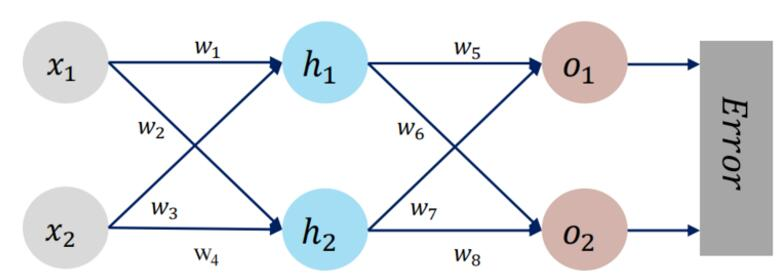神经网络与深度学习(邱锡鹏)编程练习4 FNN 正向传播 pytorch
NN模型:

ref:【人工智能导论:模型与算法】MOOC 8.3 误差后向传播(BP) 例题 【第三版】 - HBU_DAVID - 博客园 (cnblogs.com)
实验目标:
理解正向传播过程,熟悉pytorch编程。
初始值:
w1, w2, w3, w4, w5, w6, w7, w8 = 0.2, -0.4, 0.5, 0.6, 0.1, -0.5, -0.3, 0.8
x1, x2 = 0.5, 0.3
y1, y2 = 0.23, -0.07
输出:

源代码1
import torch.nn as nn
import torch
def forward_propagate(x, w1, w2): # 正向传播
h = nn.Linear(2, 2) # 输入层,线性(liner)关系
h.weight.data = w1
h.bias.data = torch.Tensor([0.0])
h_out = torch.sigmoid(h(x))
o = nn.Linear(2, 2) # 输入层,线性(liner)关系
o.weight.data = w2
o.bias.data = torch.Tensor([0.0])
o_out = torch.sigmoid(o(h_out))
return o_out
if __name__ == "__main__":
w1 = torch.Tensor([[0.2, 0.5], [-0.4, 0.6]])
w2 = torch.Tensor([[0.1, -0.3], [-0.5, 0.8]])
x = torch.tensor([0.5, 0.3]) # 输入值
y = torch.tensor([0.23, 0.07]) #
print("输入值:x1, x2;", x, "\n输出值:y1, y2:", y)
out_o = forward_propagate(x, w1, w2)
print("输入值:x1, x2;", x, "\n输出值:y1, y2:", out_o)源代码2:
整理为 class Net(nn.Module)形式,为将来学习“训练模型”代码做准备
import torch
import torch.nn as nn
class Net(nn.Module):
# 初始化网络结构
def __init__(self, input_size, hidden_size, num_classes):
super(Net, self).__init__()
print(input_size, hidden_size, num_classes)
self.fc1 = nn.Linear(input_size, hidden_size) # 输入层,线性(liner)关系
self.sigmoid = torch.nn.Sigmoid() # 隐藏层,使用ReLU函数
self.fc2 = nn.Linear(hidden_size, num_classes) # 输出层,线性(liner)关系
# forword 参数传递函数,网络中数据的流动
def forward(self, x, w1, w2):
# print("x:",x)
self.fc1.weight.data = w1
self.fc1.bias.data = torch.Tensor([0.0])
out = self.fc1(x)
print("h_in:", out)
# print(self.fc1.weight.data)
out = self.sigmoid(out)
print("h_out:", out)
self.fc2.weight.data = w2
self.fc2.bias.data = torch.Tensor([0.0])
out = self.fc2(out)
print("o_in:", out)
# print(self.fc2.weight.data)
out = self.sigmoid(out)
# print("o_out:", out)
return out
net = Net(2, 2, 2)
if __name__ == "__main__":
x = torch.tensor([0.5, 0.3])
y = torch.tensor([0.23, -0.07]) # y0, y1 = 0.23, -0.07
w1 = torch.Tensor([[0.2, 0.5], [-0.4, 0.6]]) # 一般情况下,参数无需初始化,让机器自己学习。 有时,初始化参数可提高效率。
w2 = torch.Tensor([[0.1, -0.3], [-0.5, 0.8]])
print("输入值:x1, x2;", x, "\n输出值:y1, y2:", y)
out_o = net(x, w1, w2)
print("输入值:x1, x2;", x, "\n输出值:y1, y2:", out_o)

